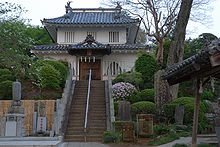- Makino Sadamichi
-
In this Japanese name, the family name is "Makino".
Makino Sadamichi (牧野 貞通, December 26, 1707 – October 30, 1749) was a Japanese daimyo of the mid-Edo period.[1]
The Makino were identified as one of the fudai or insider daimyō clans which were hereditary vassels or allies of the Tokugawa clan, in contrast with the tozama or outsider clans.[2]
Contents
Makino clan genealogy
The fudai Makino clan originated in 16th century Mikawa province. Their elevation in status by Toyotomi Hideyoshi dates from 1588.[2] They claim descent from Takechiuchi no Sukune,[3] who was a legendary Statesman[4] and lover of the legendary Empress Jingu.[5]
Sadamichi was part of a cadet branch of the Makino which was created in 1680.[2] These Makino resided successively at Sekiyado Domain in Shimōsa province in 1683 ; at Yoshida Domain at Mikawa province in 1705; at Nabeoka Domain in Hyūga province in 1712; and, from 1747 through 1868 at Kasama Domain (80,000 koku) in Hitachi province.[3]
 A corner tower of Kasama Castle in modern Kasama, Ibaraki.
A corner tower of Kasama Castle in modern Kasama, Ibaraki.
The head of this clan line was ennobled as a "Viscount" in the Meiji period.[3]
Tokugawa official
Sadamichi served the Tokugawa shogunate as its nineteenth Kyoto shoshidai in the period spanning July 2, 1742 through October 28, 1749.[1] Sadamichi was the father of Makino Sadanaga, who was the twenty-eighth shoshidai. He would be distantly related to the fifty-fifth shoshidai, Makino Tadayuki (1824–1878), who was descended from the elder Makino branch.[3]
Notes
- ^ a b Meyer, Eva-Maria. "Gouverneure von Kyôto in der Edo-Zeit." Universität Tübingen (in German).
- ^ a b c Alpert, Georges. (1888). Ancien Japon, p. 70.
- ^ a b c d Papinot, Jacques. (2003) Nobiliare du Japon -- Makino, p. 29; Papinot, Jacques Edmond Joseph. (1906). Dictionnaire d’histoire et de géographie du Japon. (in French/German).
- ^ Brasch, Kurt. (1872). "Japanischer Volksglaube," Mitteilungen der deutschen Gesellschaft für Natur- und Völkerkunde Ostasiens, p. 56. (in German)
- ^ Guth, Christine. "Book Revies: Japan's Hidden History: Korean Impact on Japanese Culture by Jon Carter Covell and Alan Covell," Numen. 33:1, 178-179 (June 1986).
References
- Appert, Georges and H. Kinoshita. (1888). Ancien Japon. Tokyo: Imprimerie Kokubunsha.
- Meyer, Eva-Maria. (1999). Japans Kaiserhof in de Edo-Zeit: Unter besonderer Berücksichtigung der Jahre 1846 bis 1867. Münster: Tagenbuch. ISBN 3-8258-3939-7
- Papinot, Jacques Edmund Joseph. (1906) Dictionnaire d'histoire et de géographie du japon. Tokyo: Librarie Sansaisha...Click link for digitized 1906 Nobiliaire du japon (2003)
- Sasaki Suguru. (2002). Boshin sensō: haisha no Meiji ishin. Tokyo: Chūōkōron-shinsha.
External links
Categories:- Daimyo
- Makino clan
- Kyoto Shoshidai
- Hatamoto
- 1707 births
- 1749 deaths
- Japanese nobility stubs
Wikimedia Foundation. 2010.
